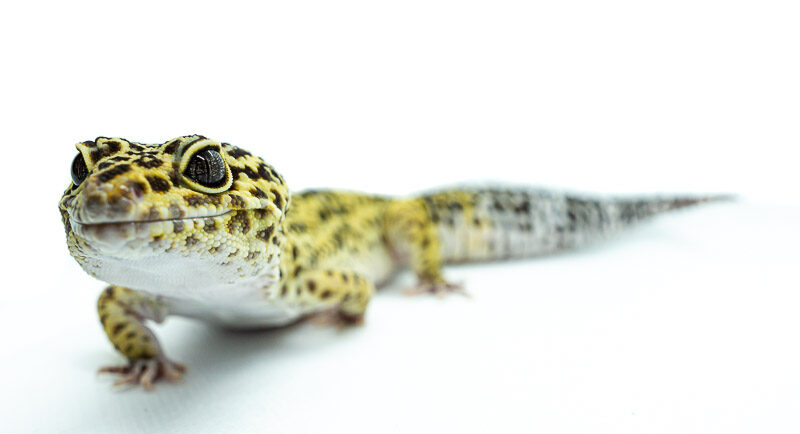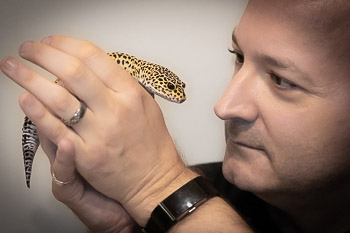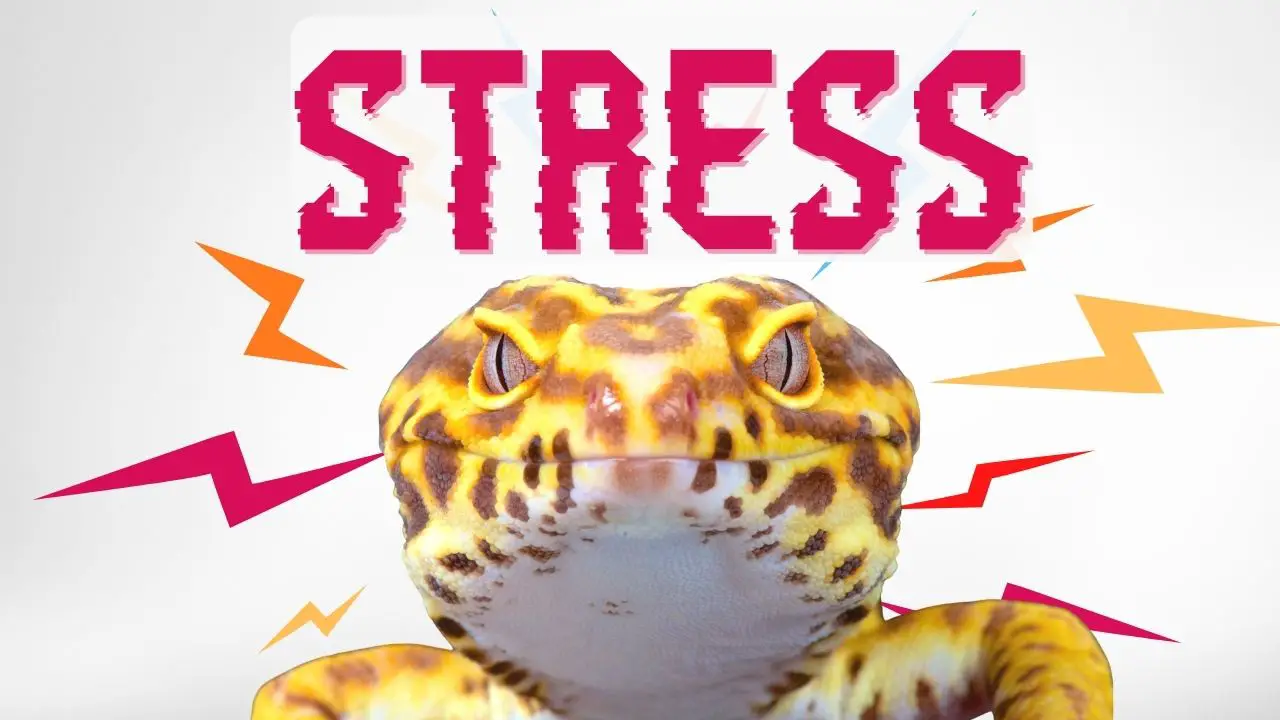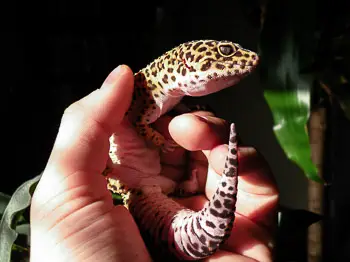So, you’ve decided on a pet leopard gecko, got your habitat set up, and are getting your new friend settled in. You’re bound to have some “new owner” leopard gecko questions as you’re learning how to care for yours. We’ve compiled some common leopard gecko questions into a new owner leopard gecko guide.
What do you do when you first get a leopard gecko? Read on for the answers.
Why does my leopard gecko get spooked every time I try to pick it up?
This may be as simple as your gecko is in a new environment may take some getting used to its new home. Give it a day or two to settle in and realize it is safe and see if it relaxes a bit.
It may be a matter of how you approach the tank and open the enclosure:
Sound and Noise
Sounds can play a factor in spooking your gecko. Does the sound of opening the tank or enclosure startle the gecko? Sounds and noise can be a factor, especially if your gecko is new and not used to associating the sound of the tank opening with feeding or handling.
Or are you a ninja that makes no noise at all, and suddenly grabs the gecko with no other warning. The sudden touch could be a surprise and your gecko could have a fight or flight response.
Some owners like to talk to their gecko so it recognizes their voice, while other will make a certain sound like calling a dog or cat. This gives your leo a cue that you’re there before you reach in.
Approaching your gecko
Reaching down abruptly from above is the same approach a predator may take when trying to eat the gecko. Try approaching slowly from the side within the gecko’s line of site as to not surprise it.
Our leopard gecko enjoys a gentle rub on the head, and I’ll always do that first before trying to pick him up. This way, he’s been conditioned to know that after he gets a bit of a rub on the top of his head, he may be picked up directly afterward.
How often should I feed my gecko?
For younger leopard geckos, every day. Around a year, this might taper off to every other day. Beyond that, every two to three days is a good feeding schedule for an adult leopard gecko.
Check out our leopard gecko feeding guide for everything you need to know about feeding.
Why is my leopard gecko not eating?
It’s common for leopard geckos to stop eating in times of stress, like just being brought home and placed into a new environment.
Other major changes may cause stress and affect your geckos appetite. Once they realize there isn’t any danger and calm down, they should resume eating normally.
If your leopard gecko still isn’t eating after several days have passed, there may be something more serious. If your gecko was not in the best of health when you brought it home or was kept in an enclosure with other geckos that may have been sick, your gecko could have a parasite, could be impacted, or otherwise ill. It would be best to have a vet that specializes in reptiles examine your leopard gecko if it goes through an extended period of not eating.
Female leopard geckos may stop eating for stretches during mating season, especially if they are breeding. Read more in our leopard gecko breeding guide.
I don’t think my leopard gecko is drinking. What should I do?
Leopard geckos do drink water, though they may not do so frequently. They won’t drink enough to visibly affect the water level in the bowl, so it may look like they are not drinking.
Leopard geckos should always have access to fresh water. You can read more about your leopard gecko’s need for water, water bowls, and setup in our post: Do Leopard Geckos Drink Water.

Why is the leopard gecko spending so much time in the warm hide?
If you just brought it home, your leopard gecko may simply be hiding. Once it feels safe in the environment, it will start to venture out (especially if you’re tempting it with food.)
Remember, leopard geckos will sleep during the day, so it’s common that they stay in the hide while they sleep.
It’s also possible that the rest of the tank may be too cool, and the warm hide is the only spot it’s comfortable.
Why won’t my leopard gecko go into the warm hide?
Some leopard gecko owners notice the opposite behavior, where their gecko won’t go into the warm hide. Check your temperature. First, you want to make sure your warm hide is, well, warm. There should be a difference in in temperature from the warm side (about 90 °F – 32 °C) and cool side (about 80 °F – 27 °C) of the enclosure.
You don’t want it too hot, and if the heat builds up inside the hide it may be uncomfortable.
If you’re having trouble with the temperature, consider getting a thermostat to control your heat mat, and a thermometer for each side of the enclosure.
Related Post: Best Leopard Gecko Heat Sources
If I pick up the leopard gecko, will its tail fall off?
While leopard geckos can drop their tails, this is a defense mechanism usually reserved for life or death situations. If your gecko feels extreme stress or is threatened, it may drop its tail.
This usually would not happen just by picking it up. There are things you can do to help your leopard gecko feel more comfortable.
- Recognize its body language and warnings
- Do not corner it
- Do not chase it
- Don’t pick it up by the tail
Find out more about your leopard gecko’s body language and tail in this post.
Why does my leopard gecko lick me? (or the ground, or its hide, or literally everything it encounters)
Don’t worry. Your leopard gecko isn’t tasting you or sizing you up as a snack. It’s just exploring its environment through taste (and smell.)
Like many reptiles, leopard geckos have a Jacobson’s organ, which is between their mouth and nose. This lets an animal ‘smell’ through their tongue, so to speak.
It’s common and absolutely normal for your leopard gecko to lick you and the things around it, especially if they are new.
Related Post: Do Leopard Geckos Have Teeth?
How can I tell how old my leopard gecko is?
Hatchlings and juveniles are fairly easy to guess the age. Once the leopard gecko gets to adulthood, say after one year it gets much more difficult to tell.
If you’re buying (or inheriting) and adult leopard gecko, if will be difficult to accurately place the age. Our leopard gecko looked the same at 10 years as he did at 5 years. (If only humans aged as gracefully, right?)
How can I tell what morph my leopard gecko is?
Some morphs with dominant genes on display are (fairly) easy to tell apart. If the genes are preset but recessive, (referred to as “het” traits) it can be much harder to tell. A leopard gecko could be carrying some highly desirable genes, though still appear like a “normal” run of the mill leopard gecko.
You can read more about what makes a morph in our post he genetics and science behind morphs .
Is my leopard gecko lonely? Should I get my leopard gecko a friend?
In a word: No. Your gecko does not need (and probably does not want) a friend.
Leopard geckos are usually solitary creatures in the wild, and prefer their own space in captivity.
You can read more in our posts about leopard geckos being kept together, or are leopard geckos social.





